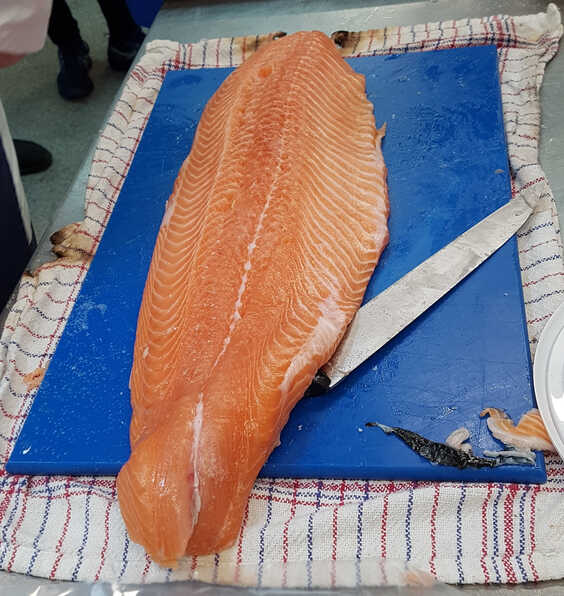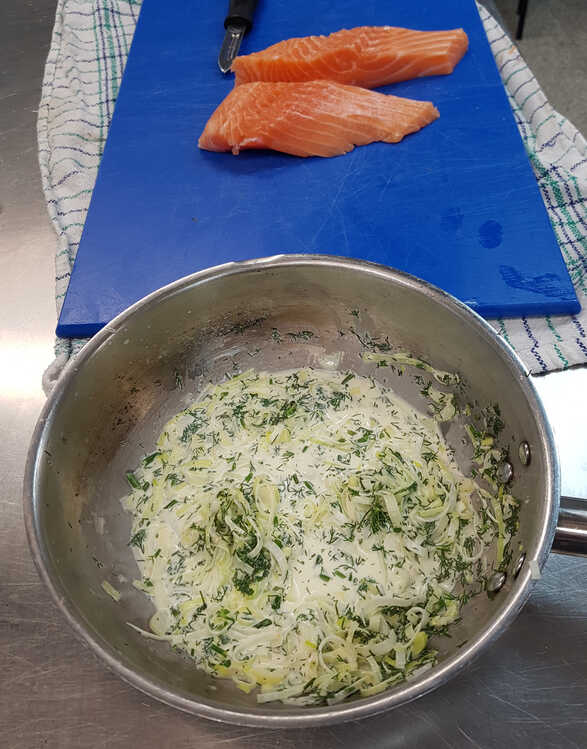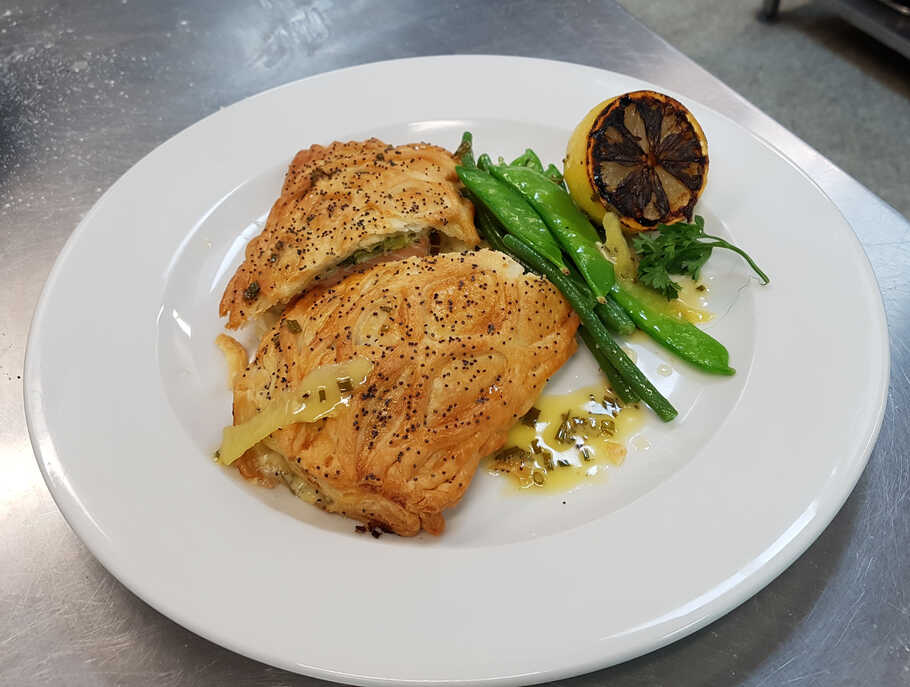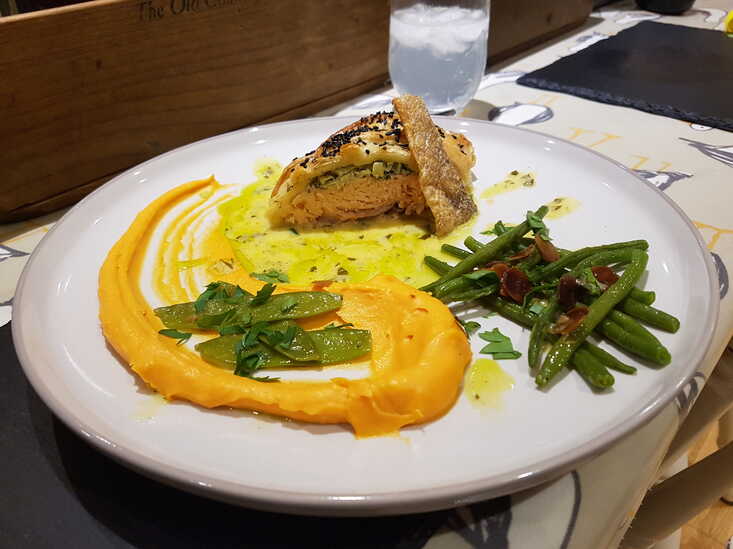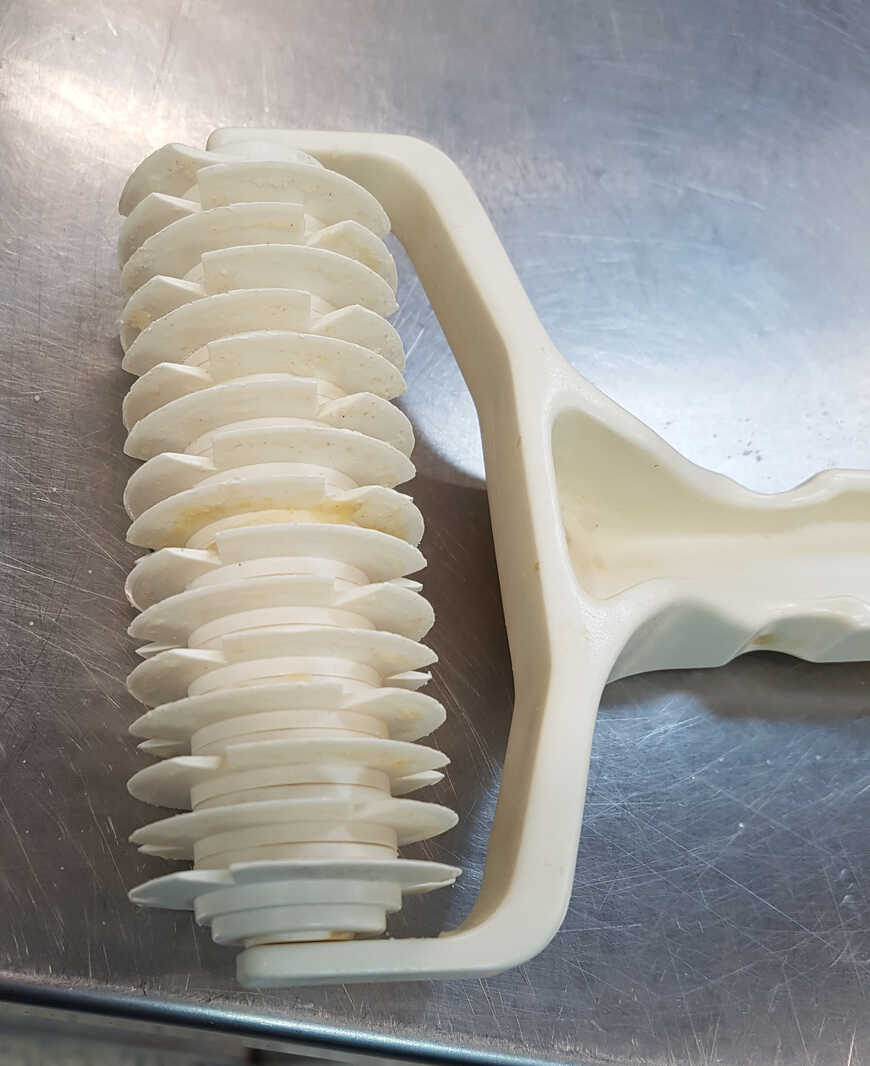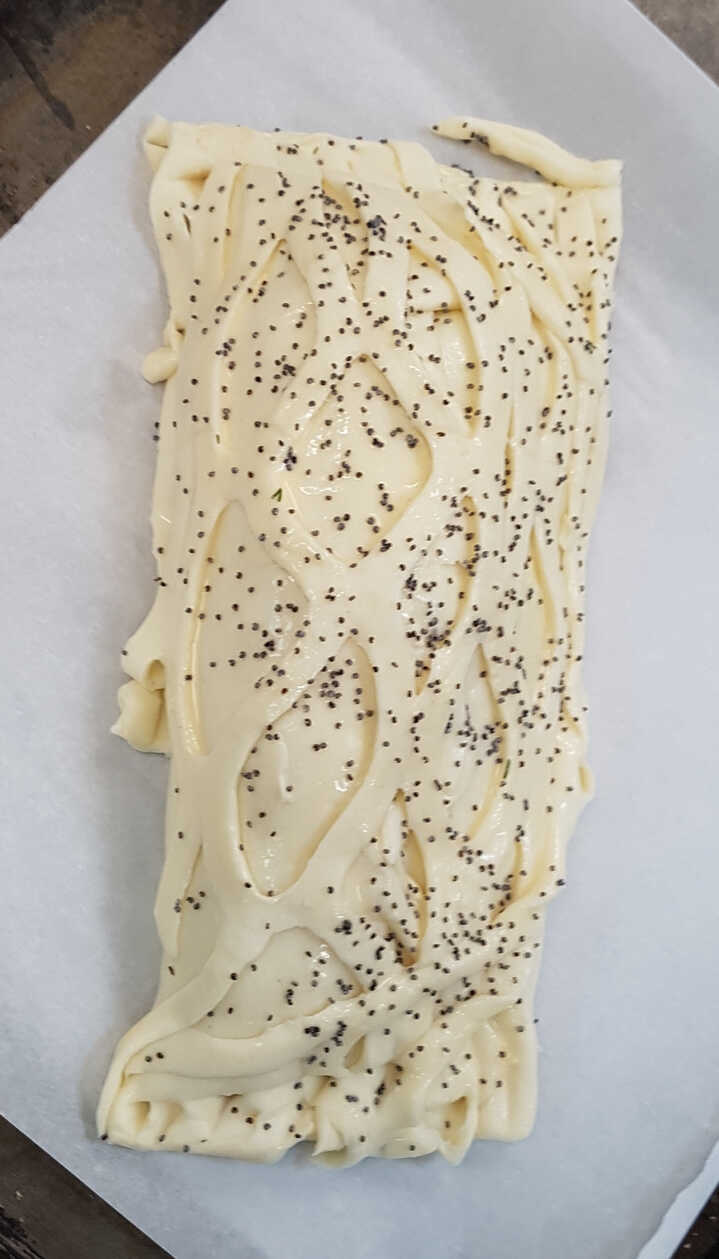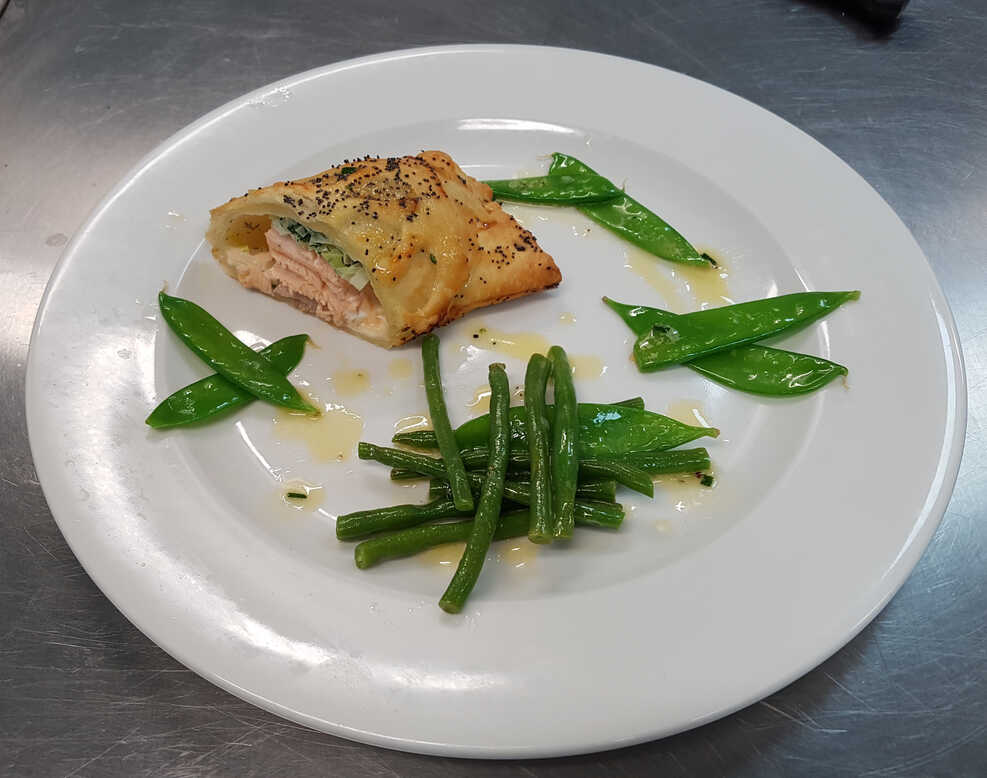Culinary Masterclass 3 - Crusty Salmon
A new Masterclass course and a new instructor!
Lee has a background in certifying apprentice chefs to work in the industry - so is unsurprisingly keen on health and safety. He immediately set to work establishing the class' ground rules:
He has already dispensed many useful cooking tips during the course of demonstrating tonight's dishes including:
You should only add them to already boiling water and return them to the boil over a high heat.
It's also good to add a dash of salt to the water which will not only season the vegetables, but serves to raise the boiling point of the water and cook them even quicker.
You want to have a little bite left in cooked fresh green vegetables so avoid over-cooking them.
If you aren't serving them immediately then you should drain and plunge them into iced water to quickly cool them which will preserve their green colour.
When you are finally ready to serve you can either throw them into boiling water again or, as Lee controversially suggests, reheat them in a microwave.
Root vegetables, on the other hand, with their thick starchy cells are best brought to the boil in cold water. This will give the insides time to come up to temperature too, and reduce the risk of over-cooking and disintegrating the surface before the vegetables are cooked all the way through.
As someone's mother has it: If it grows in the hot hot sun, put it in boiling water to cook. If it grows in the cold cold ground put it in cold water to cook.
And who could argue with someone's mother?
On the subject of making cream sauces - in order to whip cream so it holds air you will need it to have 30-35% fat content or higher,
and cream which has less than a 25% fat content will likely split when brought to a boil, especially in the presence of anything acidic.
UK creams have the following fat contents:
The class was blessed with whole sides of salmon costing around £30 each, to cut down for the croûtes and Lee discussed their quality and demonstrated how to prepare them...
Good fresh salmon will smell of the sea and not urine, its flesh will be quite elastic and (eventually) spring back when pressed in.
It will be a pale orange colour, not the artificially bright colour of preservatives, will not have too much fat marbling, and its scales will be still firmly attached.
For the salmon en croûte you want to remove the skin first which saves the tedious and messy job of de-scaling for which you want a very sharp filleting knife that is longer than the widest part of the fish.
Lay the fish skin-side down.
Starting from the tail end, cut down through the flesh to the skin then orient the knife horizontally.
Now generously salt the tail end of the skin and your fingers which will help prevent them from slipping and grip it firmly. Pulling tightly on the skin with one hand, work the knife along the skin with the other, cutting it free with as little attached flesh as possible.
There will likely be small bones still in the fish, particularly the larger pin bones which run down the middle of the fish from the head to roughly two-thirds of the way to the tail.
Run your hands over the fish to feel for these and pull them out with your fingers or a pair of pliers or tweezers.
Lee showed us an ingenious method of using a potato peeler to get out the larger pin bones:
You will need a traditional, double-gapped, non-swivelling potato peeler. Here's what you do with it — make as if you were going to peel the salmon flesh where the head of a pin bone projects.
Direct the peeler so the pin bone enters the upper slot.
You then roll the peeler so the upper slot moves away from the fish. This should have the effect of the slot edges grabbing the bone. You can also press on the protruding bone with your thumb to make sure it holds.
Now you can pull the peeler away from the fish in the direction the bone is pointing, and it should come out cleanly.
Lee has a background in certifying apprentice chefs to work in the industry - so is unsurprisingly keen on health and safety. He immediately set to work establishing the class' ground rules:
- NO RUNNING WITH KNIVES!
Knives to be carried held loosely at the side and pointing downwards at all times. - NO CATCHING THROWN KNIVES!
Or dropped ones.
He has already dispensed many useful cooking tips during the course of demonstrating tonight's dishes including:
- Stabilize your chopping board by laying a damp cloth or tea towel underneath it.
- To prevent pastry sticking when rolling, flour the surface as lightly as possible so as not to dry the pastry out.
- When using your knife to cut, say a salmon parcel, if you have to press on the knife - it's not sharp enough. It should cut naturally without pressure when sawed back and forth.
- You can make your egg wash with egg yolks, whites or whole eggs mixed into either milk or cream.
Egg white will make the baked pastry shiny, while the yolk will add a golden colour. - If it grows above the ground start in hot water, if it grows below then start in cold.
You should only add them to already boiling water and return them to the boil over a high heat.
It's also good to add a dash of salt to the water which will not only season the vegetables, but serves to raise the boiling point of the water and cook them even quicker.
You want to have a little bite left in cooked fresh green vegetables so avoid over-cooking them.
If you aren't serving them immediately then you should drain and plunge them into iced water to quickly cool them which will preserve their green colour.
When you are finally ready to serve you can either throw them into boiling water again or, as Lee controversially suggests, reheat them in a microwave.
Root vegetables, on the other hand, with their thick starchy cells are best brought to the boil in cold water. This will give the insides time to come up to temperature too, and reduce the risk of over-cooking and disintegrating the surface before the vegetables are cooked all the way through.
As someone's mother has it: If it grows in the hot hot sun, put it in boiling water to cook. If it grows in the cold cold ground put it in cold water to cook.
And who could argue with someone's mother?
On the subject of making cream sauces - in order to whip cream so it holds air you will need it to have 30-35% fat content or higher,
and cream which has less than a 25% fat content will likely split when brought to a boil, especially in the presence of anything acidic.
UK creams have the following fat contents:
- Single: 18%
- Whipping: 36%
- Double: 48%
- Clotted: 55%
- Soured: 18%
- Crème Fraîche: 48%
The class was blessed with whole sides of salmon costing around £30 each, to cut down for the croûtes and Lee discussed their quality and demonstrated how to prepare them...
Good fresh salmon will smell of the sea and not urine, its flesh will be quite elastic and (eventually) spring back when pressed in.
It will be a pale orange colour, not the artificially bright colour of preservatives, will not have too much fat marbling, and its scales will be still firmly attached.
For the salmon en croûte you want to remove the skin first which saves the tedious and messy job of de-scaling for which you want a very sharp filleting knife that is longer than the widest part of the fish.
Lay the fish skin-side down.
Starting from the tail end, cut down through the flesh to the skin then orient the knife horizontally.
Now generously salt the tail end of the skin and your fingers which will help prevent them from slipping and grip it firmly. Pulling tightly on the skin with one hand, work the knife along the skin with the other, cutting it free with as little attached flesh as possible.
There will likely be small bones still in the fish, particularly the larger pin bones which run down the middle of the fish from the head to roughly two-thirds of the way to the tail.
Run your hands over the fish to feel for these and pull them out with your fingers or a pair of pliers or tweezers.
Lee showed us an ingenious method of using a potato peeler to get out the larger pin bones:
You will need a traditional, double-gapped, non-swivelling potato peeler. Here's what you do with it — make as if you were going to peel the salmon flesh where the head of a pin bone projects.
Direct the peeler so the pin bone enters the upper slot.
You then roll the peeler so the upper slot moves away from the fish. This should have the effect of the slot edges grabbing the bone. You can also press on the protruding bone with your thumb to make sure it holds.
Now you can pull the peeler away from the fish in the direction the bone is pointing, and it should come out cleanly.
menu
Crusty Salmon
Salmon En Croûte
Sweet Potato Purée
Salmon En Croûte
The centrepiece
Green Beans with Almonds
The obligatory greenery.
Lemon Butter Sauce
The flavour
Sweet Potato Purée
Some optional starch.
Salmon en Croûte
fish main
Cut 2" slices of skinless, deboned salmon across the width of a side of fish.
If you weren't baking them en croûte you might cut these fillets at a 45° angle to make them look pretty.
But it's inconvenient to wrap such an odd shape in pastry - so just cut them straight across like a normal person.
If you weren't baking them en croûte you might cut these fillets at a 45° angle to make them look pretty.
But it's inconvenient to wrap such an odd shape in pastry - so just cut them straight across like a normal person.
Serves 4
Ingredients
- 4 salmon fillets
- 1 leek
- splash double cream
- generous handful of dill
- salt & pepper
- 2 packs ready-rolled puff pastry, about 600g
- egg wash of choice
- poppy or sesame seeds for decoration
Trim the leek to white parts only, halve lengthways, and slice finely.
Wash in salted water.
Cover a chopping board with baking parchment. Cut a square of puff pastry large enough to enclose a fillet of salmon.
Place the salmon in the centre and cover the top with the infused leeks, doing your best to include as little runny cream as you can.
Remove any excess cream which dribbles off with kitchen roll.
Brush the pastry all around with egg wash, then carefully fold around the salmon pressing it close so as to avoid air pockets.
Trim away any excess pastry and crimp it shut around the edges, squeezing out any trapped air.
Now for the artistic part where you decorate the croûte:
Brush the egg wash all over the surface of the parcel.
If you're lucky enough to have a lattice pastry roller you can run that along a pastry square - don't go right to the edges.
Now lift up the square so the lattice-work opens up and drape it over your salmon parcel.
Press down and trim et voilà - instant style points.
If you don't happen to be working in a professional kitchen then you'll have to cut strips from your pastry trimmings and layer them criss-cross over the parcel like a peasant.
Boo!
Brush the parcel once again with the egg wash, sprinkle with poppy seeds or sesame seeds, for extra charm, and put in the fridge until ready to bake.
Preheat the oven to 180°C Fan/190-200°C Conventional/Gas Mark 5-6.
Lay a clean sheet of baking parchment on an oven tray and transfer the prepared salmon parcels to the tray.
Allow the baked parcels to rest for 10 minutes while you prepare the vegetables.
Our catering-background supervisor likes the mild anti-bacterial qualities of salty water, in his professional capacity.
Dress the leeks with just enough cream to lubricate them and set them on the stove to heat through.
You are not trying to cook them - only barely bring them to the simmering point so that the flavours can meld and infuse.
You also don't want more cream than will coat the leek - it will only run off the salmon later otherwise.
Chop up the dill and stir it through the leeks off the heat. Season with pepper and a little salt. Put into the fridge to cool.
You also don't want more cream than will coat the leek - it will only run off the salmon later otherwise.
Be sure to include the dill stalks - they are very soft and contain as much flavour as the fronds. Or more!
Again our catering-background instructor does not countenance combining a hot sauce with cold fish, since in a professional environment this could become a breeding ground for bacteria if the finished parcel is to hang around waiting for a diner to arrive to bake it for, on demand.
If you're cooking this immediately at home though, it probably won't matter if the leek is warm - though chilled cream will be firmer and easier to work with.
Again our catering-background instructor does not countenance combining a hot sauce with cold fish, since in a professional environment this could become a breeding ground for bacteria if the finished parcel is to hang around waiting for a diner to arrive to bake it for, on demand.
If you're cooking this immediately at home though, it probably won't matter if the leek is warm - though chilled cream will be firmer and easier to work with.
Cover a chopping board with baking parchment. Cut a square of puff pastry large enough to enclose a fillet of salmon.
Place the salmon in the centre and cover the top with the infused leeks, doing your best to include as little runny cream as you can.
Remove any excess cream which dribbles off with kitchen roll.
Brush the pastry all around with egg wash, then carefully fold around the salmon pressing it close so as to avoid air pockets.
Trim away any excess pastry and crimp it shut around the edges, squeezing out any trapped air.
The steam from cooking will tend to separate the pastry from the fish in any case, but do your best.
You can counter this by adding a wrapping a layer of pancake around the fish before the pastry - as for beef wellington.
You can counter this by adding a wrapping a layer of pancake around the fish before the pastry - as for beef wellington.
Now for the artistic part where you decorate the croûte:
Brush the egg wash all over the surface of the parcel.
If you're lucky enough to have a lattice pastry roller you can run that along a pastry square - don't go right to the edges.
Now lift up the square so the lattice-work opens up and drape it over your salmon parcel.
Press down and trim et voilà - instant style points.
If you don't happen to be working in a professional kitchen then you'll have to cut strips from your pastry trimmings and layer them criss-cross over the parcel like a peasant.
Boo!
Brush the parcel once again with the egg wash, sprinkle with poppy seeds or sesame seeds, for extra charm, and put in the fridge until ready to bake.
Preheat the oven to 180°C Fan/190-200°C Conventional/Gas Mark 5-6.
Lay a clean sheet of baking parchment on an oven tray and transfer the prepared salmon parcels to the tray.
We lift them onto a fresh piece of baking parchment to avoid the egg wash pooling underneath and burning while baking.
Bake for 20-30 minutes until the top is golden. Check on them after 20 minutes.Allow the baked parcels to rest for 10 minutes while you prepare the vegetables.
I puréed up some sweet potato with butter and cream to add starch to the dish.
(As previously prepared for my Street Food Tacos.)
I also decorated the parcel with a shard of crispy fried salmon skin (since I we had skin from a whole side of salmon!) and split my lemon butter sauce with some basil oil.
I also decorated the parcel with a shard of crispy fried salmon skin (since I we had skin from a whole side of salmon!) and split my lemon butter sauce with some basil oil.
Lemon Butter Sauce
sauce veg
Beurre monté is just about the simplest butter sauce - you just whisk butter into hot water to make a glossy emulsion.
Well, you can do the same thing with lemon juice or white wine. Other citrus fruit may also be available.
I would say, that if you're going to use wine you should probably reduce it by half first. And it might be a good idea to add a splash of vinegar. Acid helps to emulsify the butter.
The butter should be cold, or at least cool, so that its addition keeps the liquid temperature under control. You need to maintain the temperature between 70°C and 88°C - if you allow it to boil, or get too cool, it will split.
Well, you can do the same thing with lemon juice or white wine. Other citrus fruit may also be available.
I would say, that if you're going to use wine you should probably reduce it by half first. And it might be a good idea to add a splash of vinegar. Acid helps to emulsify the butter.
The butter should be cold, or at least cool, so that its addition keeps the liquid temperature under control. You need to maintain the temperature between 70°C and 88°C - if you allow it to boil, or get too cool, it will split.
Serves 4
Ingredients
- juice of 1 lemon
- lemon zest optional
- about 50g cold butter
Heat the lemon juice and fat zest slices if you like for extra flavour in a small until it reaches simmering point.
Season and use immediately - although possible it is quite tricky to keep it warm for very long, and it doesn't reheat at all.
You can add a splash of double cream to the juice, for instance the surplus from creaming some dill leeks, to help stabilise the sauce.
Lower the heat and begin adding lumps of butter whisking or shaking! continuously.
Keep adding butter until the sauce reaches your desired consistency without it curdling.. It should be rich and glossy, thick enough to coat the back of a spoon.
Off the heat you can stir through some herbs or finely minced garlic if you like.Season and use immediately - although possible it is quite tricky to keep it warm for very long, and it doesn't reheat at all.
If you made too much, or it splits, you might try chilling it and then reconstituting it by whipping it into a fresh batch of hot liquid.
Maybe.
Remove the zest chunks when using. Unless you want mouthfuls of lemon peel!
Maybe.
Remove the zest chunks when using. Unless you want mouthfuls of lemon peel!
Green Beans with Almonds
side veg
A very natural combination.
Almonds go equally well with many green vegetables such as sprouts.
Which you might think about next Christmas.
Which you might think about next Christmas.
Serves 4
Ingredients
- 200g fine beans
- 100g mangetout or peas optional
- handful almond flakes
- knob of butter
- salt & pepper
Spread almond flakes in an oven-proof dish and set under the grill, or in a 180°C oven for 5 minutes to toast.
You will need to watch them like a hawk towards the end - they will go from beautifully golden to on fire in no time!
Trim the ends from your fine green beans and the stalky end of the mangetout.
Bring a pot of salted water to the boil. Drop in the beans and return to the boil. Simmer for 7 minutes.
Towards the end you can throw in some mangetout and bring back to the boil and cook for 90 seconds.
Trim the ends from your fine green beans and the stalky end of the mangetout.
Bring a pot of salted water to the boil. Drop in the beans and return to the boil. Simmer for 7 minutes.
Towards the end you can throw in some mangetout and bring back to the boil and cook for 90 seconds.
I think Lee's timing is a bit off here - 7 minutes seems like a lot. I'd cook the green beans for only 3-5 minutes.
And mangetout will be ready almost instantly.
You want them to be still bright green and retain a little crispness.
Strain the vegetables and toss them with the toasted almonds and a knob of butter. Season with salt and fresh pepper. Throw in some chopped parsley if you have some.
You could also add a splash of lemon juice or a grating of lemon zest.
